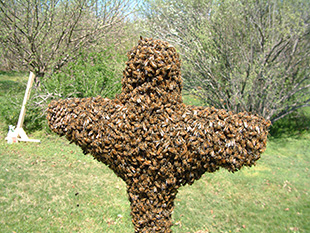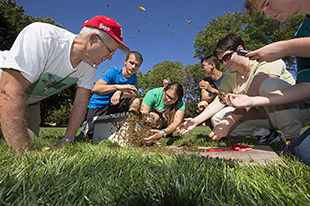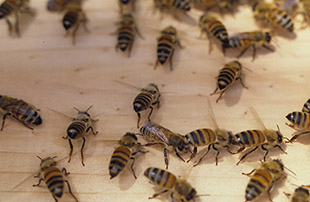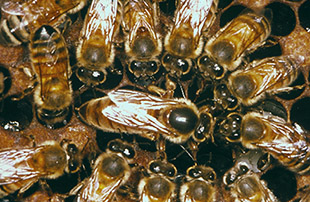G2225
How to Set Up and Conduct a Honey Bee Swarm Biology Demonstration
A resource for beekeepers, teachers, and scientists who want to use an artificial swarm to teach others about honey bees and the biology of the swarming process.
Marion D. Ellis, Extension Entomologist
- Background
- Preparation
- The Day of the Demonstration
- The Demonstration
- Precautions
- Handout for Participants
- Honey Bee Swarm Biology Review Questions
|
Background
A honey bee swarm is one of the most amazing phenomena in the natural world. When a colony swarms, thousands of bees leave their home and set up a temporary bivouac (Figure 1) from which they send out scouts to evaluate potential nest sites. The scouts return to the bivouac and perform a dance that communicates to their nest mates the location of any potential nest site found. The scouts then investigate potential nest sites indicated by other scouts, and upon returning to the bivouac, dance to indicate the better nest site. When all the scouts are dancing the same dance, the swarm becomes airborne and moves to the new nest site. When swarming, bees have neither young nor food to protect, and their defensive instincts are minimal.
The purpose of this demonstration is to teach participants about pheromones and how the orientation and queen pheromones function in coordinating swarming.
Preparation
Prepare the swarm by shaking 3-4 pounds of nurse bees into a package bee cage provided with a caged mated queen. This can be accomplished by shaking the adult bees from brood frames from one or more hives. Each frame covered with bees will yield about one-half pound of adult bees, so you will need to shake 6-8 frames. A funnel helps get the bees into the cage. After shaking the bees, add a caged mated queen and a feed can of 1:1 (wt:wt) sucrose syrup. Store the bees in a cool, dark place for 72 hours. The 72 hours is essential for the bees to transition from perceiving themselves as a colony that needs to defend its home to swarm mode in which they direct their energies to staying with their queen and finding a new nest site. Bees caged for less than 72 hours may exhibit defensive behavior when the package cage is opened. It is also prudent to have an extra queen on hand. If the queen in the package cage dies, you cannot do the demonstration unless you have a spare queen to give them. If you attempt to do the demonstration with queenless bees, the bees will exhibit defensive behavior.
The Day of the Demonstration
Temperatures should be 75-95°F, and winds should not exceed 10 mph. Place a wooden cross (6-foot tall) in the ground. Three hours before the demonstration, bring the package of bees to the site and spray them liberally with 1:1 sugar syrup. Thirty minutes after feeding the bees, bounce the package bee cage to cause the bees to fall to the bottom. Spray the bees with water to minimize flight, and then remove the feed can and the caged queen. Tether the queen cage to the cross and shake the bees out of the cage. Within a half hour the bees will have found their queen and formed a bivouac around her. Thirty minutes before the demonstration, spray the bees on the cross liberally with sugar syrup. Note: If temperatures are below 65°F, or if winds exceed 15 mph, this demonstration will not work as bees will crawl in the grass rather than fly when you make the swarm airborne (ideal conditions are a temperature 75-95°F and wind not more than 10 mph).
The Demonstration
Allow the participants to come near the swarm and observe dancing on the bivouac surface. You can spread your fingers and gently pull your hand through the edge of the cluster to get a handful of bees (Figure 2). After letting the participants observe the bees on your hand, toss them into the air and let them rejoin the bivouac. Have the participants stand back approximately 40 feet. Gently remove the cross from the ground and dislodge the bees from it by making an upward thrust. Most of the bees will become airborne and begin searching for their queen (Figure 3). A small number of bees will, however, come down in the grass. At this time the participants can form a line to walk through the flying swarm and back to their original position (Figure 4).
Next, take the caged queen in your hand and move to a new position that is 20-30 feet away from where the cross was originally located. Use a 5-foot long wooden 2 x 4 to support your arm. Expose the queen cage. The first bees to find her will begin scent fanning and as the flying bees detect the odor plume, they will move to where the queen is located (Figure 5). This process typically takes 15-20 minutes. After the swarm reforms on your arm, bring a 5-frame nuc box with empty combs and place it near the swarm. Place a 3 x 3 foot sheet of plywood on the ground in front of the nuc box and dislodge the swarm from your arm onto the plywood. When the bees begin marching in, remove the caged queen from your hand and spray her with water (to prevent flight). Open the queen cage and place the empty queen cage on the plywood and near the hive entrance. Release the queen among the bees that are marching in (Figure 6). Tell participants to observe scent fanners and how large numbers of bees cluster on the empty queen cage long after the queen is gone.
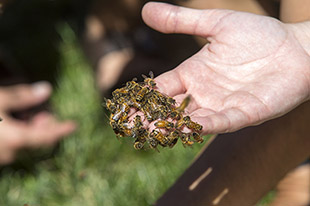 |
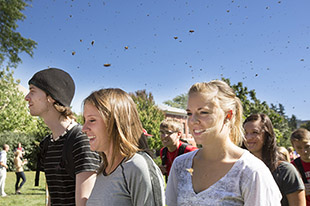 |
|||
Figure 2. Handful of bees |
Figure 3. Walking thru swarm |
|||
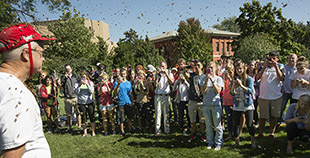 |
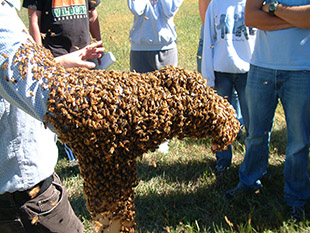 |
|||
Figure 4. Standing in swarm |
Figure 5. Bee bivouac forms on presenter’s arm |
|||
|
||||
Precautions
Presenters should tape their pant legs, as bees will crawl up vertical objects, and they should put cotton in their ears and nose, as bees will crawl into dark cavities. Presenters should have an assistant to explain what is happening while the swarm is settling on the presenter’s arm, as bees will fly into open mouths. Presenters can attach the queen cage to their chin and let the swarm form a bee beard; however, doing so may make the presenter appear to be a circus act, and participants may pay too much attention to the act and miss all the good biology there is to learn. It is prudent to do the demonstration several times without an audience to fine-tune your techniques. It is important to have several knowledgeable assistants to explain the biology and answer questions while the presenter manipulates the bees. Note that bees void their waste on the wing, so be sure to set up the swarm three hours before participants arrive to give them time to take a cleansing flight.
This publication has been peer reviewed.
DisclaimerReference to commercial products or trade names is made with the understanding that no discrimination is intended of those not mentioned and no endorsement by University of Nebraska–Lincoln Extension is implied for those mentioned. |
Visit the University of Nebraska–Lincoln Extension Publications website for more publications.
Index: Insects & Pests
Other Pests
Issued February 2014
